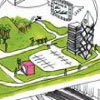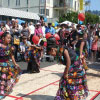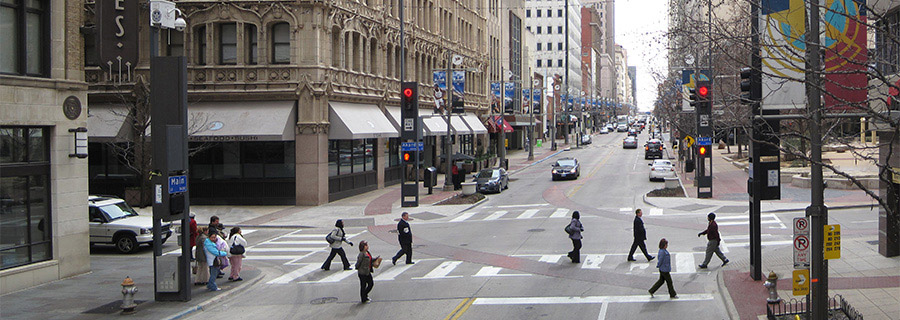
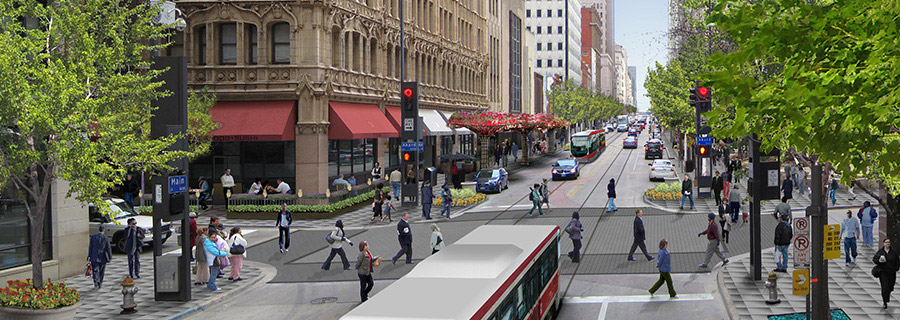
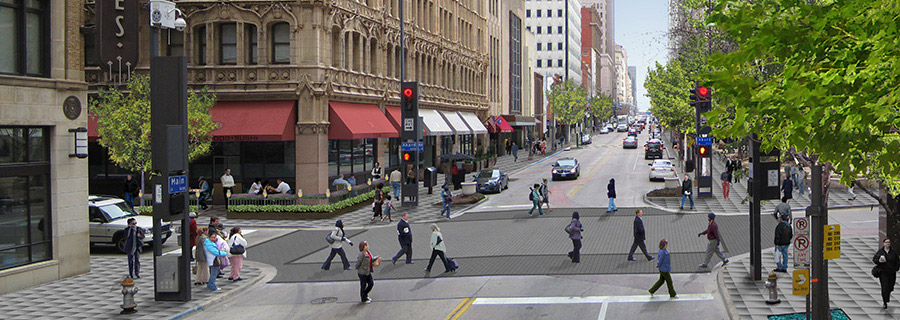
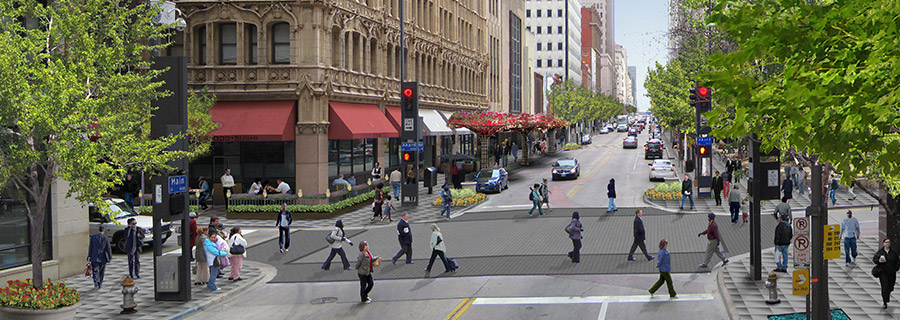

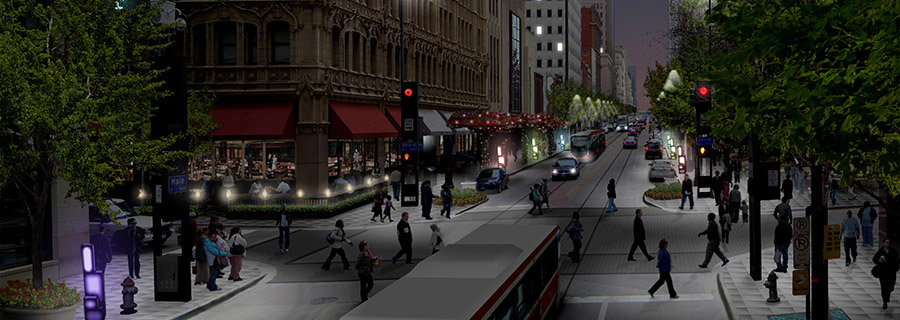
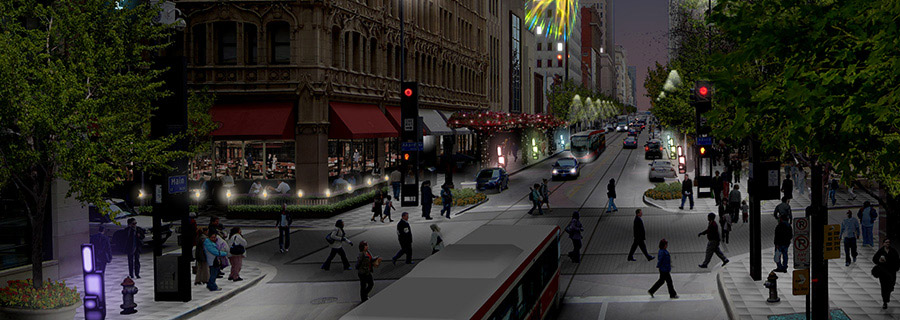
The development of street image may be defined as preserving, creating, enhancing and expressing the unique character of the street and the surrounding area through streetscape elements, architecture and visual place-making features.
Layers of history, architecture of buildings and private realm land uses all contribute to creating a unique identity for a street. However, this topic focuses on how the place making and design of the street realm can help create an identifiable street.
The shape and character of most iconic streets that developed in the 20th century were formed primarily to serve the automobile and the pedestrian realm was of secondary importance. In looking at the old, historic streets of Europe and Asia and the more recent examples of iconic streets in America, Europe and Asia we see that a strong pedestrian environment is critical to image and identity and establishment of a strong sense of place. These streets are clearly serving residents and visitors, are thriving commercial successes and are encouraging local pride and public stewardship.
The Need for Image and Identity
Iconic streets imbued with a lasting image and grounded sense of place is essential component to all urban and rural cities and towns. Not all streets can have a regional or city-wide iconic identity, however some streets take on that role of telling the story of the area and the larger region it represents. Iconic streets have a magnetic quality that attracts people, business and commerce that makes them natural and appropriate venues for public events. The scale and character of these streets distinguish them from others to make the most significant examples beacons of community pride and ownership. In today’s world of mass produced product and culture, streets with special identity stand out in their ability to contribute to a community’s need to recognize and celebrate its own distinct historic social and cultural heritage, and natural environmental context.
Streets designed for image and identity should aim to meet the following overall goals:
- Establish an identity that reflects the aspirations of the immediate community and describes the larger neighborhood or district.
- Reinforce and enhance the tangible and intangible connection to the local social, cultural, physical (manmade and natural) and where applicable historic context.
- Develop pride and ownership for the local residents and workers who will help maintain the street.
Streets designed for image and identity should include a diversity of activities including but not limited to:
- Identifying
- Interpreting
- Viewing
- Expressing
- Informing
- Orienting
- Consuming – eating, drinking, shopping, etc.
- Browsing, window shopping
- Socializing
- Lounging, people-watching
- Performing
- Dancing
- Other
The following image and identity street types can be supported and facilitated through the design of the street environment:
- Downtown main streets, as the original historic commercial mixed-use traffic street continue to be a major thoroughfare for the city, but also function as an important work center, public gathering space, administrative core and shopping destination. Clearly marked and signaled crosswalks and intersections, high quality furnishings and streetscape plantings.
- Neighborhood main streets are a smaller-scale form of downtown main streets that are characterized by walkable services, cafes, pubs, and locally-owned retail most easily accessible to residents living within a 1/4 to 1/2 mile radius. Simplified street layout, few traffic lanes, marked crossings and street furniture characterize this type.
- Arts and cultural entertainment districts showcase the intermingling of artist galleries and studios, and cultural and entertainment destinations. These districts may choose unique signage, paving design, murals or on-street installations to communicate what is offered there. Often, these districts are expressions of a city’s desire to diversify its economic base and create venues for cultural expression through physical revitalization, investment and implementation of sponsorship programs that help sustain and make artists more visible.
- Historic districts are collections of buildings, properties, sites and streets that help define the historical character of a place. They can be residential, commercial, industrial, etc. in nature. Emphasis is usually on built period structures, but typically there are also street furnishings, streetscape materials and landscape elements that reflect the historic character. Historic districts protect buildings, properties and other features from owner-initiated alterations that denigrate the holistic physical integrity of the district's features.
- Industrial districts have distinctive buildings types, flexible formats and larger scaled streets that respond to the transport, manufacturing and distribution functions of industrial urban commerce, often in conjunction with major transportation infrastructure such as rail yards, highway onramps or waterfront port facilities.
- Residential neighborhood streets, supporting the needs of single-family, multi-family, townhome and other residences. Simple street layout, slow moving and low traffic volumes, and family friendly street furniture characterize this type.
A combination of elements and amenities are essential to creating streets with an iconic identity. Some support business activities themselves, and some provide a comfortable environment for pedestrians.
- Structures – gateways, memorials, water fountains, etc. Structural features such as gateways, monuments, memorials and water fountains (where climatically and environmentally appropriate) function as navigation landmarks along a street. Structures share contextual information with uses - through materials, method of construction, design and fabrication - which to provide enhanced understanding of the urban environment presented at the street level.
- Banners and flags – Decorative and identifying banners and flags display a range of cultural, political and social cues, symbols and icons significant to the street's audience.
- Signs and posters – Directional, informational or promotional in nature, signs and poster displays direct people to key locations and help to orient people to events that are scheduled to take place on the street or at nearby locations.
- Shelters – Structures that provide people protection from the elements, noise, and traffic. They can be designed to become a place of respite from the crowds or active place for activities such as picnicking. They also can provide information and in the case of transit shelters indicate access points to public transit available from the street. Shelters should have an appearance that strengthens the overall image and identity of the street.
- Planting – trees, shrubs, grasses - Landscape arrangements at the streetscape level include trees, shrubs and ground cover plantings in medians or sidewalks, and vegetated rain gardens and bioswales/detention planters.
- Seating – Seating elements along a street can include a variety of benches, table seating with movable chairs, seat walls, art elements and planting containers. Seating features welcome and invite people to linger on the street. Seating should receive regularly scheduled maintenance to ensure safety and quality appearance while discouraging loitering and attracting undesirable elements.
- Art (community, functional, abstract) – Art plays an important role in streets to bring beauty and interest and provoke dialogue among users of the site. Art includes two-dimensional painting or mosaics, or three-dimensional sculpture, and can be integrated into street furniture such as benches, trash receptacles, lighting hardware, landscaping or parking. Art maybe public, or provided by private property owners.
- Murals – Murals function as visual narratives of a neighborhood or street's cultural or social history, often using bright colors, symbols and other elements reflective of the resident or emerging culture. Murals can be commissioned pieces or spontaneous projects with little planning, but they generally are created with the assistance, input and feedback of the community.
- Lighting – Street lighting comes from diverse sources of fixtures - illuminated pavement, lit bollards, overhead street lighting, gas lamps, other pedestrian-scaled lighting elements often with pendant fixtures and other decorative details. The type of lighting on a given street is reflective of the major function and audience it will serve (urban and rural), and should address pedestrian safety.
- Digital displays – Digital displays are useful when the nature of information provided on a street changes rapidly or without notice. They can be installed on the sides of buildings, within kiosks, on the ground, as part of a gateway structure and at building entrances, etc.
- Sound – Audible advertisements notices, directions, etc are often used on streets at crosswalks, at transit stops and at street entrances to buildings.
- Smell – Olfactory elements that assist people in one of the most powerful ways as the sense of smell is the strongest sense. It can be incorporated in naturally scented trees, flowers and herbs, as well as outdoor displays and activities such as outdoor dining, stands of fruits and vegetables, etc.
- Play features – Child and adult friendly recreational features such as climbing wall, play equipment, etc.
- Amenities – Basic amenities such as water fountains for humans and dogs, bike parking, etc. that are preferably custom-designed to strengthen the overall image of the street.

